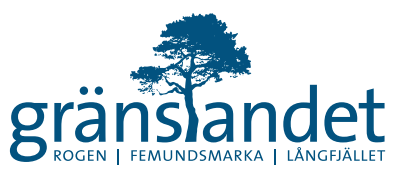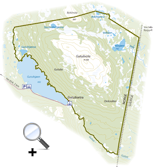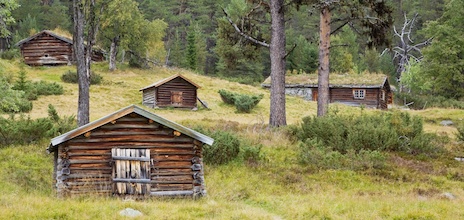 Gutulia. Photo: Kentaroo Tryman.
Gutulia. Photo: Kentaroo Tryman.
Gutulia
View from the highest peak
Gutulia is Norway’s smallest national park, which despite its size contains great diversity. You can look out over virtually the entire national park from the highest mountain peak, Gutulivola, 949 metres above sea level. The peak is bare and softly rounded. From here you see the outlines of the second tallest peak, Baklivola, against the backdrop of the tall mountains in Femundsmarka to the north. Between the peaks is a beautiful valley with open, patchy bogs. The valley stretches towards Lake Valsjøen, with its water resting like a blue eye in the north-eastern corner of the national park.
Gutulia’s slopes are a billowing sea of old-growth forest, unusually lush for these parts. Lake Gutulisjøen and the river Gutua form the western boundary of the national park.
Gutulisetra – the finest summer pasture in the area
At the south-eastern end of Lake Gutulisjøen is the beautiful mountain holding Gutulisetra. It comprises three pastures – Nedpåvollen, Oppåvollen and Lillebovollen. The sun-weathered timber buildings on the slope down to the lake look idyllic, but life on the summer farm was not always so easy. It was hard work, with meadow hay-making, milking and dairy production.
At one time, the bells of mountain cattle and women’s herding calls were heard from the lakeside slopes. From the mid-1750s, farmers from Lillebo and Sorken by Lake Femunden brought their livestock here every summer to graze. Mountain farming was carried out until 1949. After that, the old buildings fell into disrepair until the Norwegian Ministry of the Environment employed people skilled in traditional craftsmanship to restore the 13 log cabins between 1975 and 1983.
Even if a long time has passed since the Gutulisetra pastures were cut with a scythe, the buildings are still surrounded by flowering meadows, with species such as harebell, oxeye daisy, alpine bistort and moonwort.
Meeting giant trees
The pines and spruces in Gutulia have survived many generations of human beings. The age of the trees has been determined by core-boring. Some spruces are more than 300 years old, and the oldest pines are more than 400 years old! Storfurua (giant pine) and Storgrana (giant spruce) on the way to Gutulisetra are particularly splendid specimens.
Many of Gutulia’s old trees are unusually tall for Gränslandet. Trees taller than 30 metres are not uncommon here. This is not only due to their age, but also because the soil is relatively nutritious.
The forest has largely been left to develop at its own pace. That’s why there are so many dead trees. Pines that remain standing after their death, mummified by resin. Or decaying old-growth spruces and fallen spruce trunks, covered in moss.
Ancient forest
Gutulia gives you an idea of how forests looked in Scandinavia before the invasion of forestry. There are not many signs of axes and saws. One reason could be that the watercourses run towards the Swedish side, which made westward timber transport difficult.
Some timber and wood for household requirements has been cut around the mountain holding. The oldest forest in the national park is therefore found on the slopes of the other side of Mount Gutulivola.
Marked by fire
Forest fires have occurred several times in Gutulia; the latest was in the 1860s. Even today, you can find burnt tree stumps and other traces of the recurring forest fires.
Animals and plants
At first sight the old-growth forest may seem lifeless – but appearances are deceptive. There are plenty of birds and all of Scandinavia’s four large predators are regular visitors to the national park. But you need both patience and a bit of luck to see them. There is more likelihood of spotting the majestic golden eagle patrolling its territory in search of food.
Most inhabitants in the old-growth forest are much smaller. The old and decaying tree trunks are home to many beetles, lichens and mosses.
Some of Gutulia’s inhabitants leave clear traces. A dug-out ant-hill could be the sign of a bear’s supper. Rings in the bark of spruces have been pecked by three-toed woodpeckers. Beavers disappeared for a long period, but returned in the 1960s. Their presence is now clearly evident along the river Gutua.
Reindeer pastureland
Gutulia is part of the Elgå reindeer grazing district, the southernmost Sami pastureland in Norway. The area provides pasture for reindeer belonging to the Sami in Svahken Sitje. On your own From the parking area outside the national park is a trail of around 3 kilometres, which takes you to Gutulisetra. Smaller paths lead to Storfurua, around 1 kilometre south of Gutulisetra, and to Storgrana, some 500 metres north of the holding. There are no other marked trails in the national park, but with the aid of a map, compass and a good sense of direction you can still get around on your own.
Please refrain from camping at the mountain holding. Campers are referred to the campsite by the river Gutua.
 Cairn on the top of Mount Gutuliavola.
Cairn on the top of Mount Gutuliavola.
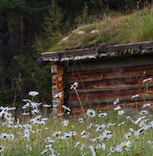 Flowering oxeye daisies surround the buildings.
Flowering oxeye daisies surround the buildings.
 A tiny pine plant in the 17th century – now a gigantic tree. Photo: Marcus Elmerstad.
A tiny pine plant in the 17th century – now a gigantic tree. Photo: Marcus Elmerstad.
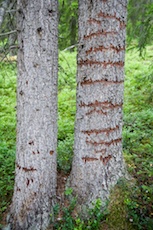 Traces of three-toed woodpecker. Photo: Marcus Elmerstad.
Traces of three-toed woodpecker. Photo: Marcus Elmerstad.
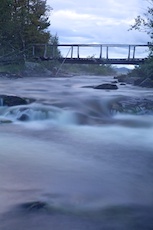 The river Gutua forms the southern boundary of the national park.
The river Gutua forms the southern boundary of the national park.
Other photos: Naturcentrum AB.
Links
Norwegian Directorate for Nature 1 »
Norwegian Directorate for Nature 2 »
Reading tip
Lauritzen, P. R. & Vangen, O. 2007: Femundsmarka och Gutulia. Norges Nasjonalparker. Den Norske Turistforening og Statens naturoppsyn/Direktoratet for naturforvaltning.
Visitors are permitted to:
- go anywhere on foot or ski.
- pick common plants, berries and fungi for own use.
- pitch a tent, but not for longer than one week in the same place without permission from the County Governor of Hedmark.
- fish subject to regulations.
- cautiously light a fire with dry branches, or your own logs, but remember the general ban on lighting fires in Norwegian forests from 15 April to 15 September.
Visitors are not permitted to:
- damage land, rocks or vegetation.
- damage living trees, dead trees or fallen tree trunks.
- disturb animal life.
- damage cultural monuments.
- drive motor vehicles or ride bicycles.
- make organised tours on horseback.
- use motorised ice drill.
- pollute or leave litter.
- camp for more than a week in one spot.
Full regulations are found here »
There are also other laws and regulations to consider.
The purpose of the protection is
- to preserve a largely untouched landscape of woodland, bogs and hills.
- to preserve the biological diversity, with its distinctive flora and fauna.
- to safeguard cultural monuments.
Brief facts
Year: Established in 1968 and extended in 2004
Name: Gutulia National Park
Area: 23 kilometres
Municipality: Engerdal
County: Hedmark
Landowner: Public land
Supervision, safety regulations: Norwegian Nature Inspectorate
Nature conservation manager: County Governor of Hedmark
